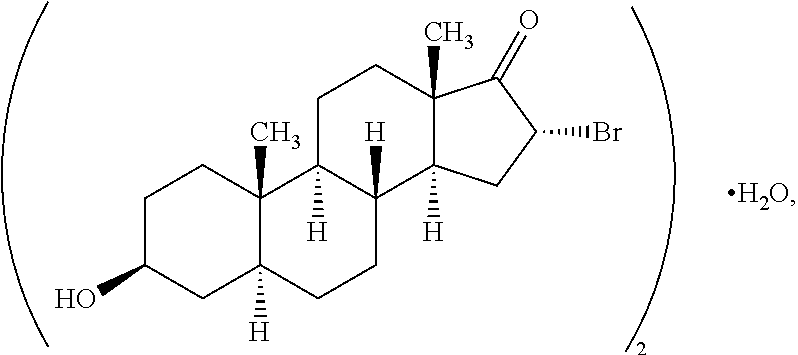Steroids having 7-oxgen and 17-heteroaryl substitution
a technology of heteroaryl and oxgen, which is applied in the field of steroid 7oxgen and 17heteroaryl substitution, can solve the problems of compound serious limitations, excessive or inappropriate immune responses, and inability to fully respond to agents,
- Summary
- Abstract
- Description
- Claims
- Application Information
AI Technical Summary
Benefits of technology
Problems solved by technology
Method used
Image
Examples
specific embodiments
[0401]Aspects of the invention and related subject matter include the following specific embodiments and are not intended to limit the invention in any way.
[0402]1A. A compound having the structure
[0403]
[0404]or a salt thereof, provided that if a double bond is present at the 4-5- or 5-6-positions, then —H at the 5-position is absent and is otherwise present in the α- or β-configuration or if a double bond is present at the 1-2-, 4-5- or 5-6-positions, then R10A, R10B or R10C, respectively, are bonded to the ring to which they are linked by a single bond;
[0405]wherein one each of R1, R2 and R3 is —H; one of R4 is —H or an optionally substituted alkyl group; the other R1 is —OH; the other R2 is —H, —OH, —CH3, a halogen or an alkoxy or both R2 together are ═O or ═CH2; the other R3 is —H, halogen, —OH or an ester or both R3 together are ═O or ═CH2; the other R4 is —NH2, —N(RPR)2, an optionally substituted amine moiety, an optionally substituted amide group, an N-linked amino acid or bo...
example 1
[0857]Cystic fibrosis treatment. Treatment with a F1C is conducted on human cystic fibrosis (“CF”) patients, e.g., 18 years of age or older, who may have two or more of the following characteristics: (1) sweat chloride ≧60 mEq / L, e.g., by quantitative pilocarpine iontophoresis test, (2) homozygosity for the F508 genetic mutation, or heterozygosity for 2 well-characterized mutations, e.g., as described herein, associated with CF, (3) FEV1≧40% predicted at screening, (4) SaO2≧90% at screening, (5) ability to perform pulmonary function tests and (6) clinical stability, with no evidence of acute upper or lower respiratory tract infection or current pulmonary exacerbation. The treatment regimen consists of 1, 2, 3, 4 or 5 consecutive days of once daily dosing of a F1C or placebo equivalent followed by a 40-day observation period. Daily dosages are about 10-150 mg / day, e.g., about 25 mg / day, 50 mg / day, 75 mg / day or 100 mg / day. The F1C is administered as described herein such as by a paren...
example 2
[0858]Cyclodextrin formulation. A cyclodextrin formulation containing a F1C is prepared by mixing a sulfobutyl β-cyclodextrin and the F1C in one or more liquids such as ethanol, DMSO, N-methylpyrrolidine, pyridine or water. The sulfobutyl β-cyclodextrin contains one or more butyl sulfonate or —O—(CH2)4—SO3−Na+ moieties, typically about 5, 6 or 7 per cyclodextrin molecule. F1Cs that contain a positive charge are especially helpful in forming complexes with the multiple negative charges of sulfobutyl cyclodextrin. For parenteral formulations, the maximum concentrations could be achieved at about the maximum cyclodextrin concentration that is still syringable, about 50% w:v. The F1C can be added to a solution of sulfobutyl β-cyclodextrin at a molar ratio of about 1:1, e.g., 0.5:1 to about 2:1, and stirred with or without heat for up to about 1 week to form the complex. The solution is optionally filtered or sterilized before filling in vials or injection delivery by any route. The vial...
PUM
 Login to View More
Login to View More Abstract
Description
Claims
Application Information
 Login to View More
Login to View More - R&D
- Intellectual Property
- Life Sciences
- Materials
- Tech Scout
- Unparalleled Data Quality
- Higher Quality Content
- 60% Fewer Hallucinations
Browse by: Latest US Patents, China's latest patents, Technical Efficacy Thesaurus, Application Domain, Technology Topic, Popular Technical Reports.
© 2025 PatSnap. All rights reserved.Legal|Privacy policy|Modern Slavery Act Transparency Statement|Sitemap|About US| Contact US: help@patsnap.com



